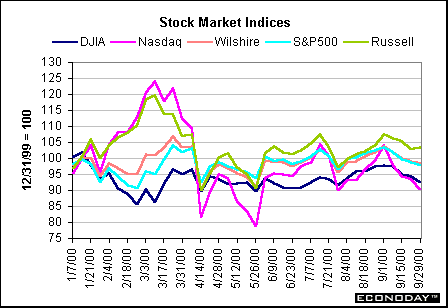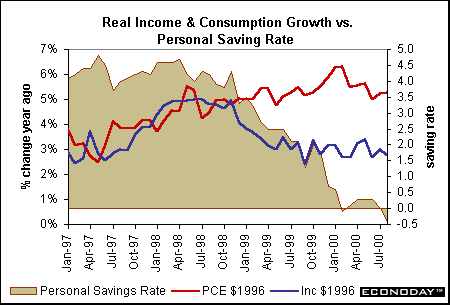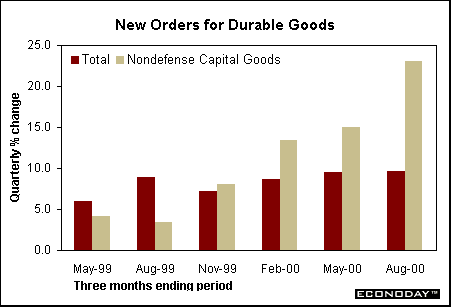| |||||||||||||||||||||||||||||||||||
| Previous Articles |
|
A few bad apples...and all come tumbling down
Treasury prices drift higher this week
Bond investors were range-bound these past couple of days as the Rosh Hashanah holiday thinned markets. Also, market players tend to be at a standstill near FOMC meetings. Most players expect the Fed to leave rates unchanged on Tuesday and to also maintain the current bias "with the potential for heightened inflationary pressures." Some investors are talking about a neutral bias, but that is not factored into current prices.
Old (GDP) News The foreign sector showed a smaller drag than initially estimated with more export growth and slightly less import growth. Make no mistake, imports still expanded at a whopping 18.6 percent in the second quarter but the initial reading had shown a 19.5 percent growth rate. Despite the slight upward revision in GDP growth, corporate profits were virtually unchanged from the initial estimate as the GDP deflator was revised down to a 2.4 percent rate from 2.6 percent. After-tax profits were 17.5 percent higher than a year ago. This was better than the first quarter, but lower than the fourth quarter of last year, as indicated in the chart below. All in all, this is a good showing for profits. Most analysts are predicting more modest profit gains in the second half of the year. Given the weaker stock market picture, that's not a surprise.
The bottom-line on GDP growth? Although GDP growth was revised higher, as were final sales to a 3.9 percent rate from 3.5 percent, there was a big inventory pile-up during the quarter. And while the final sales figures were revised up from last month's estimate, they were growing much more slowly than the first quarter pace of 6.7 percent. Often, a moderation in final sales growth coupled with an increase in the rate of inventory building signals future production cutbacks when the inventory building is not planned. We don't know for certain that the inventory stocking was not desired, but other economic data signal that possibility. Most economists are now predicting that GDP growth in the second half of 2000 will come in at a 3.5 percent rate or so. That would please Federal Reserve policymakers. As to the second quarter figures, Fed officials realize that is the rearview mirror and they must look ahead, not backwards. Consumer spending behavior unchanged
The lack of savings on the part of consumers signals strong optimism. Consumer savings typically decrease during economic expansions. The drop in savings is just more dramatic this time around. As long as the economy continues to grow at a rapid clip, this isn't a problem because consumers keep up debt payments. However, as soon as job conditions deteriorate, the high debt loads will lead to bankruptcies. Indeed, the Wall Street Journal reported just this past week on the high debt loads carried by middle income families. These could turn even uglier if conditions suddenly worsen. In the meantime, both the Conference Board's consumer confidence index and the University of Michigan's consumer sentiment index show a high degree of optimism among consumers.
Existing home sales jumped 9.3 percent in August - reversing the 9.2 percent drop recorded in the previous month. Sales recovered sharply in the Midwest and West but gains were more moderate in the Northeast and South. Existing home sales are now 0.8 percent below year ago levels. As indicated in the chart above, sales are clearly down from their peak, but have rebounded in the past couple of months as mortgage rates have edged down from their highs. Home sales have fluctuated somewhat dramatically in the past several months, but it is likely that sales will follow a more moderate pace in the second half of the year. The bottom-line on the consumer? Consumer spending on goods and services and investment spending on housing has moderated in the third quarter from the heady pace of late last year and early 2000. However, given the good labor market situation, consumer optimism is high and spending is continuing at a good clip. Fed officials will continue to monitor the consumer sector closely, as it is the principal support behind economic growth. Manufacturing activity picks up Durable goods orders jumped 2.9 percent in August after a whopping 13.1 percent plunge in July. Aircraft orders were the culprit behind the sharp variation. Excluding transportation, new orders rose 1.9 percent in August after declining 5.5 percent in July. Semiconductor orders have been fluctuating rather dramatically these past several months, causing nearly as much volatility in the series as aircraft. As indicated in the chart, new orders are still rising at a rapid clip in the third quarter despite the July plunge. This suggests that production schedules could be healthy in the next several months.
The bottom-line on manufacturing? Manufacturing activity has moderated in recent months, but the new orders figures along with the Chicago purchasing managers' index suggest a little bit of a pick up in the third quarter. Accelerating growth in capital spending, however, will not be considered inflationary because more capital goods on hand help to spur productivity growth. The Fed tends to be more concerned when consumer demand is higher. THE BOTTOM LINE Oil prices have surged though they're down from their highs of the past couple of weeks. Even after the federal government has released oil from its strategic reserve and Saudi Arabia announced production gains, energy prices are not declining as economists and financial market players had expected earlier this year. In addition to higher fuel oil costs for heating this winter, natural gas prices are also up dramatically. The higher energy prices may not translate into higher core inflation, but consumers will pay more for gas and oil. The Labor Department was once again left with egg on its face. It turns out that an error in the statistical process of adjusting for quality changes in goods and services caused the CPI to understate the true underlying inflation rate. After all was said and done, the CPI was revised higher by only 0.1 percentage points over the year. This should not cause Fed officials to worry about inflationary pressures, but it makes one wonder about data accuracy. (It is worth pointing out that accuracy is a common problem at statistical agencies, especially when funding is reduced.) All in all, Fed officials will probably vote to leave rates unchanged but maintain their bias towards heightened inflationary pressures. If conditions remain the same in the coming month, it is possible that the FOMC will go to a neutral bias at the next meeting in November. Looking Ahead: Week of October 2 to October 6 Monday Construction spending is expected to remain unchanged in August after posting declines in the previous two months. This reflects a downward trend in housing activity, even though overall residential and nonresidential investment spending remains relatively healthy. (Forecast range: -0.8 percent to 1.0 percent) Tuesday Market players expect new home sales will decrease 5.0 percent in August to a 900,000 unit rate after surging 14.7 percent in July. Overall housing activity remains relatively healthy. (Forecast range: 875,000 to 948,000) The FOMC is meeting on Tuesday. The market consensus believes that the federal funds rate target will remain unchanged at 6.50 percent. Also, the Fed is likely to keep their bias towards heightened inflationary pressures. Wednesday Thursday Friday The unemployment rate should remain unchanged at 4.1 percent in September. (Forecast range: 4.1 to 4.2) The market consensus shows a 0.3 percent gain in average hourly earnings in September, the same as last month. (Forecast range: 0.3 percent to 0.4 percent) The average workweek is expected to edge up to 34.4 hours from 34.3 hours in August. (Forecast range: 34.3 to 34.5) The market consensus is looking for a $10 billion gain in consumer credit in August. This would be smaller than the average for the previous two months when credit expanded by $9.4 billion in July and a whopping $14.7 billion in June. (Forecast range: -5,000 to +12,000) |
||||||||||||||||||||||||||||||||||||||||||||||||||||||||||||||||||||||||||||||||||||||||||||||||||||||||||||||||||||||||||||||||||||||||||||||||||||||||||||||||||||||||||||








